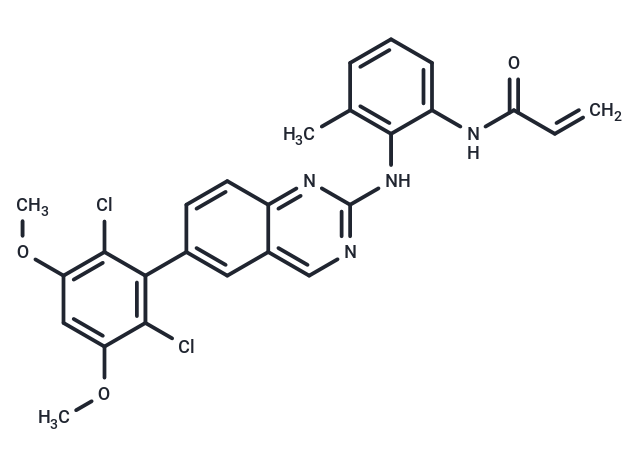Shopping Cart
- Remove All
 Your shopping cart is currently empty
Your shopping cart is currently empty

BLU9931 is the first selective small molecule inhibitor of FGFR4.

| Pack Size | Price | Availability | Quantity |
|---|---|---|---|
| 2 mg | $30 | In Stock | |
| 5 mg | $48 | In Stock | |
| 10 mg | $77 | In Stock | |
| 25 mg | $128 | In Stock | |
| 50 mg | $207 | In Stock | |
| 100 mg | $369 | In Stock |
| Description | BLU9931 is the first selective small molecule inhibitor of FGFR4. |
| Targets&IC50 | FGFR3:150 nM, FGFR4:3 nM |
| In vitro | In MDA-MB-453 cells, BLU9931 potently inhibits phosphorylation of FGFR4 signaling pathway. BLU9931 inhibits proliferation of HCC cell lines that express an intact FGFR4 signaling complex, such as Hep 3B, HUH-7, and JHH-7 cell lines, with EC50 of <1 μM. BLU9931 also inhibits proliferation in PDX-derived cell lines with an intact FGFR4 signaling pathway. [1] |
| In vivo | In mice bearing the FGF19-amplified Hep 3B liver tumors, BLU9931 (300 mg/kg, p.o.) leads to tumor regression and prevents this weight loss induced by tumors. In mice bearing the FGF19-overexpressing PDX-derived LIXC012 xenografts, treatment with BLU9931 (300 mg/kg, p.o.) also leads to tumor regression. [1] |
| Kinase Assay | FGFR1-4 Biochemical Assays: FGFR kinase inhibition assays are performed at KM for ATP. Picomolar to low nanomolar concentrations of FGFR proteins are incubated in 1× Kinase Reaction Buffer (KRB) with 1 μM of CSKtide and 50 to 250 of μM ATP at 25°C for 90 minutes in the presence or absence of a dosed concentration series of inhibitor. All reactions are terminated by the addition of Stop buffer, and plates are read on a Caliper EZReader2. IC50 values are fit with a four-parameter log[Inhibitor] versus response model with floating Hill Slope. |
| Cell Research | Established and PDX-derived HCC cell lines are seeded in 96-well plates in respective growth media, allowed to attach overnight, and treated with a dilution series of test compounds for two cell-doubling times. Cell viability is determined by CellTiter-Glo, and results represented as background-subtracted relative light units normalized to a DMSO-treated control. Relative EC50 values are determined at 50% inhibition between the top and bottom plateau of the dose–response curve.(Only for Reference) |
| Molecular Weight | 509.38 |
| Formula | C26H22Cl2N4O3 |
| Cas No. | 1538604-68-0 |
| Smiles | COc1cc(OC)c(Cl)c(c1Cl)-c1ccc2nc(Nc3c(C)cccc3NC(=O)C=C)ncc2c1 |
| Relative Density. | 1.361 g/cm3 (Predicted) |
| Storage | Powder: -20°C for 3 years | In solvent: -80°C for 1 year | Shipping with blue ice. | ||||||||||||||||||||
| Solubility Information | DMSO: 5.09 mg/mL (10 mM) | ||||||||||||||||||||
Solution Preparation Table | |||||||||||||||||||||
DMSO
| |||||||||||||||||||||

Copyright © 2015-2024 TargetMol Chemicals Inc. All Rights Reserved.